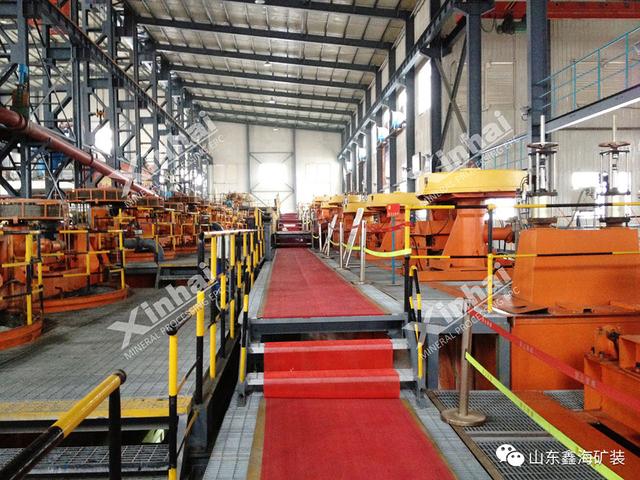As a common precious metal, there are many kinds of gold ores. Among the types of gold ores, the gold ores that are more difficult to beneficiate are micro fine grained gold ores. Generally, micro fine grained gold ores not only have the characteristics of fine embedded particle size, but also usually contain a variety of complex components that hinder the separation of gold ores, such as micro fine grained gold ores containing arsenic, sulfur and carbon. When separating these ores, it is often difficult to achieve the ideal separation effect by using simple beneficiation methods. Below, we will discuss the separation methods of these three types of gold ores respectively to overcome the difficulties in the beneficiation of fine-grained gold ores.

Usually, the carbonaceous substance in gold ore will adsorb cyanide during cyanide leaching, reduce the reaction between cyanide and gold, make it unable to act, and consume reagents at the same time. In the flotation operation, carbonaceous substances are easy to float, and adsorb flotation reagents at the same time, which increases the economic cost.
In order to avoid the interference of carbonaceous substances in the separation of gold ores, oxidation roasting or preferential carbon flotation are often used for treatment. The separation of micro fine gold ores after decarburization is relatively simple. Due to the uneven distribution of micro fine gold ores, a reasonable grinding process is required to reduce over grinding and improve the particle size composition of minerals. A part of gangue minerals can be removed by preferential flotation, The carbonaceous substances enriched in the flotation concentrate are treated by roasting, and then the gold ore is extracted by cyanide leaching. In this way, better economic indicators can be obtained.

Sulfur bearing micro fine-grained gold ore is a relatively common type of ore. in this kind of gold ore, fine-grained gold or sub micro gold exists in pyrite in a wrapped or disseminated form. Although pyrite is a mineral with good floatability, it is difficult to achieve monomer dissociation even if the grinding fineness is reduced, so it is very difficult to recover.
This kind of mineral is usually treated by multi-stage grinding and multi-stage beneficiation. Under the condition of coarse mineral particle size, rough beneficiation is carried out. Sodium carbonate, water glass, copper sulfate and butyl xanthate are used as a combination of reagents, and then closed-circuit flotation is carried out on the basis of rough beneficiation conditions to obtain gold concentrate with ideal grade and recovery rate.
In arsenic containing micro fine-grained gold ore, arsenic often exists in arsenopyrite. Arsenopyrite and micro fine-grained gold ore grow closely, and the particles are uneven. Most sulfides are easy to dissociate.
In addition, the difficulties in the separation of arsenic containing micro fine-grained gold ores lie in: first, the embedded particle size of some gold ores is very fine, and most of them are less than 0.01mm. It is difficult for gold ores and gold bearing minerals to reach the state of monomer dissociation, and they are easy to be discarded with tailings; Second, the mineral particle size is uneven. Some gold bearing pyrites with coarse particle size have many cracks, which cannot be finely ground and are easy to fracture, leading to the loss of gold ore; Third, there are many layered silicate minerals and clay minerals such as muscovite and biotite in the raw ore, which affect the flotation of gold ore.
Because the gold particle size in the gold mine is very fine, and the carrier minerals of gold are mainly pyrite, arsenopyrite or other minerals, which are very uneven in thickness and fineness, they can accept the segmented dissociation pattern, so that gold minerals can achieve efficient and proper dissociation with other minerals. And it can accept the new technology of fractional flow and fractional rate flotation. Because of the difference in the particle size of gold ore and the floatability of gangue minerals, it can accept the semi closed and semi open process for disposal, split flow, split velocity, and link subsection dissociation, expand (carry) the difference between gold ore and the floatability of gangue, so as to achieve efficient acceptance of gold. Third, use collectors with strong collecting power, such as bk903g, bk302a or Ma, to improve the flotation effect of fine gold and gold bearing minerals. Fourth, reduce the amount of sodium silicate, speed up the settlement of tailings, and reduce the amount of polymer flocculants. Fifthly, according to the requirements of ore properties and new processes, the way of adding reagents in sections is adopted to improve the effect of reagents on minerals. Above, we have described three separation methods of micro fine gold ores. In practical application, tests need to be carried out according to the actual properties of the ore, so that the beneficiation method can be combined with the ore properties to achieve the double effect of economic benefits and mineral recovery.